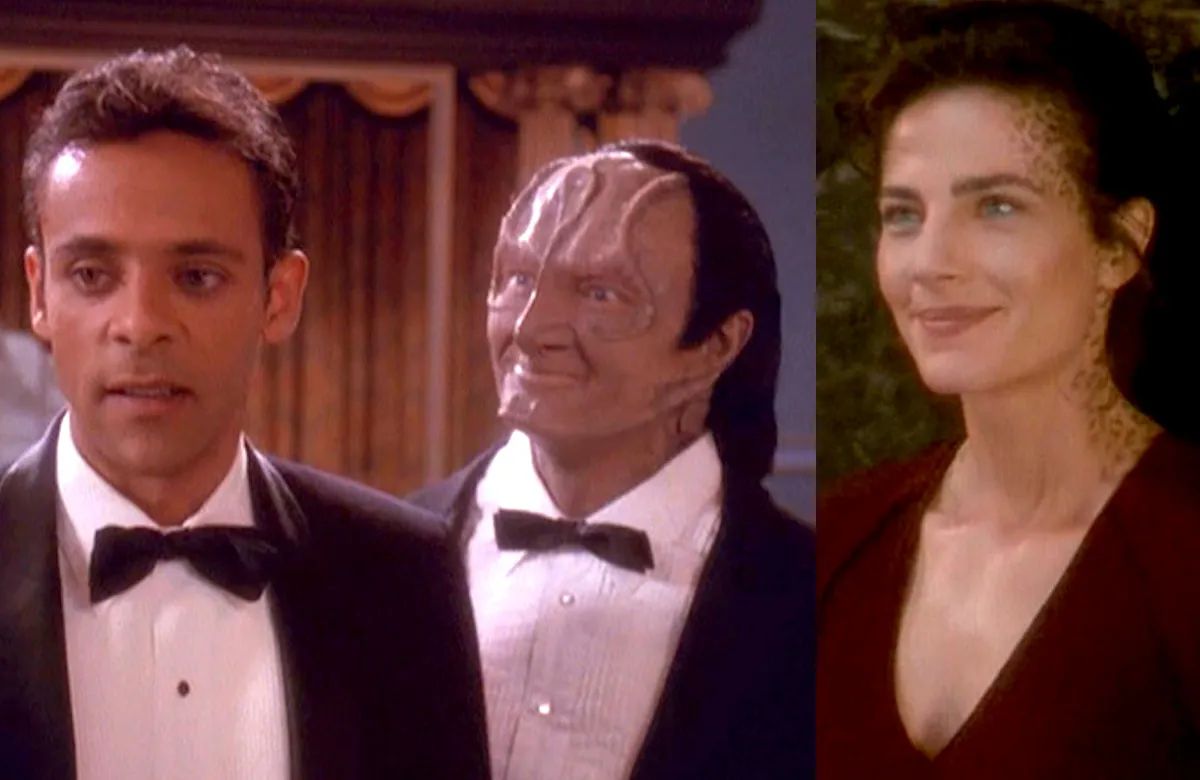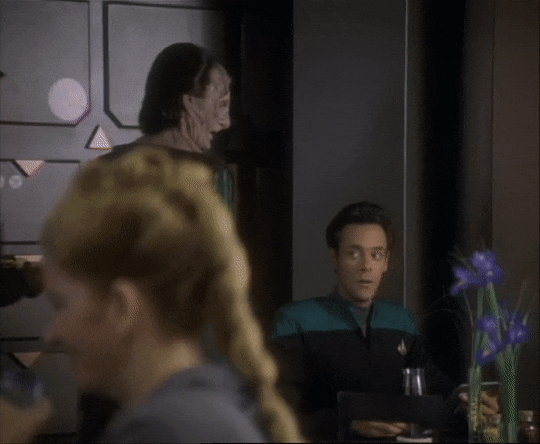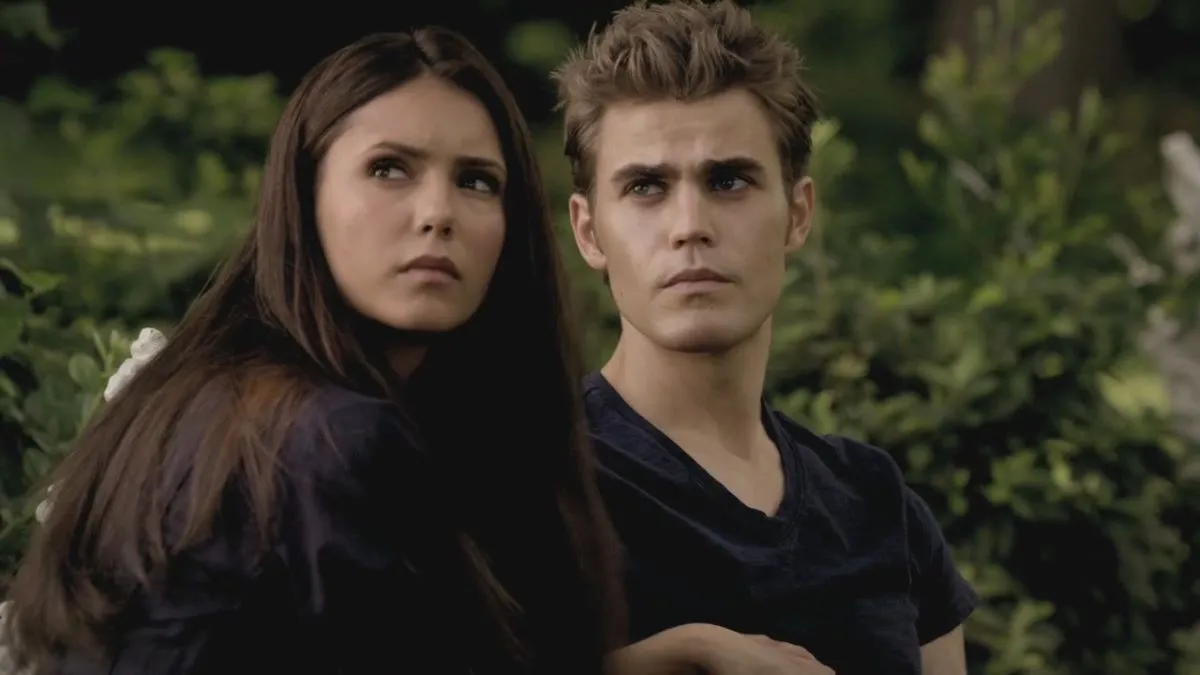While queer-coded characters are a staple across all Star Trek series, few shows have as many LGBTQ+ vibes, nuances, and allusions in them as Deep Space Nine. Not only did several actors see and portray their characters as being quite genderfluid and sexually ambiguous, but there were even multiple storylines pushing those boundaries.
However, despite the queerness their actors and stories supported, the writers tried their darnedest to fight back against what they created. While it’s tough to discern the desires of individual writers, this effort was overseen by series creator/executive producer Rick Berman, who had a history of shooting down the inclusion of queer characters in The Next Generation and has said that the decision not to include them in DS9 was his, not the studio’s.
Let’s just say this effort didn’t work out well for them.
But first, let’s set the stage by talking about two of the most impactful DS9 queer characters: Trill science officer Jadzia Dax and Cardassian tailor/spy Elim Garak.
Both characters are quite gender and sexuality transient. Neither of them conformed to any norms and had close, quasi-romantic relationships with characters of all genders. From Jadzia’s wife to Garak’s fascination with doctor Bashir, their complex romantic identities were much more omnisexual than anything heteronormative.
However, DS9′s writers never felt bold enough to confirm that, or let their characters be as fluid as they themselves set them up to be. Jadzia’s connection with Lenara in “Rejoined” was deliberately framed by their previous heterosexual marriage, and Garak’s relationship with Dr. Bashir was never allowed to be anything but platonic. Even those precautions weren’t enough, and the LGBTQ+ community saw these characters as queer icons. With that in mind, the writers engaged in an even more aggressive rebellion against Dax and Garak’s queerness, and to say it failed would be putting it mildly.
So, let’s talk about how pretending Jadzia and Garak were mostly heterosexual didn’t work.
We’ll start with Jadzia. While her relationship with her once-wife Lenara Kahn was framed in the context of their previously heterosexual marriage, the chemistry between the Khan and Dax of the present spoke to a much deeper bond than just nostalgia for who they used to be. Like the characters noted themselves, Lenara and Jadzia had much more in common than Torias and Nilani ever did.
Even if they hadn’t been together before, Lenara was totally Jadzia’s type—smart, confident, intellectual. They also weren’t torn apart because their connection was just hetersexual echoes or their attraction wasn’t real. Rather, this was a woman-loving-woman situation that got tainted by a complex history and cultural taboo. No amount of mental gymnastics can make that straight, and that’s okay.
However, the writers absolutely ignored that side of Jadzia in every other episode. For example, when she gave Sisko dating advice in “Family Business,” she threatened that if she was still Curzon, he would’ve swept Kassidy off her feet himself. However, it was inauthentic for her to imply only Curzon would be interested. Jadzia herself was flirty, bold, and loved feisty women like Kassidy. Sure, Curzon was the womanizer, but it’s little moments like these that really emphasize how the writers subtextually wrote her so queer, but were so awkwardly aggressive about keeping her words and actions straight-passing.
They also blatantly ignored her chemistry with Major Kira and any old flame she met of Curzon’s, despite all the romance and affection that still existed between them. Though she was never allowed to say anything explicitly queer, her character grew into an obviously sexually complex woman that they encouraged to toe the line with her fluidity but, beyond “Rejoined,” refused to let her explore it.
Similarly, Garak’s relationship with Dr. Bashir was always kept very cryptic and suggestive. The entire series, there was tension between them where, despite their hangups and contradictions and secrets, they were drawn to one another. There is a famously reblogged gif of Garak finding Bashir alone and looking thrilled to be able to corner the doctor all by his lonesome:
From there, their unique lunches grew into mental games of chess that turned their interest into friendship and (in the actors’ humble opinion) even more. By “The Wire,” Bashir was the only person Garak would let help him as his Obsidian Order technology failed. He told Julian half-truths and showed his worst behavior and fears, but still put his faith in the young doctor. Eventually, Bashir even got to learn about Garak’s childhood and past, more than anyone had ever known about the enigmatic Cardassian. Among everyone on the station, Julian was the only one who might know Garak for who he really was.
The actors, fans, etc. all saw the chemistry between the two. Yet, the writers avoided it like it was a plague.
Instead, Garak’s only canon relationship was not only a random Cardassian woman, but one way too young for him that he shared nothing in common with (other than their species). If they wanted to try to make it convincing, they could have at least picked someone his age who had some deep, unshakeable bond with him. Somehow, the writers’ solution was Ziyal, a young girl whose father he hated and who had a much more hopeful view on the galaxy than Garak’s cynicism could reckon with. He could protect her, like a family member might, being the only Cardassians on Deep Space Nine, but was their romance ever believable?
Absolutely not. She would have been a much more compelling romance for Jake. Think about those family dinner nights.
But Garak and Ziyal “happened,” and that act of rebellion is something most all fans prefer to ignore.
DS9 writers and Rick Berman lived in a state of denial that the queer-coded characters they created would be perceived as queer. And they failed to acknowledge it so much that when they actively tried to ignore it, reroute it, and cover it with heteronormativity, both characters didn’t seem themselves.
What seems like the obvious answer is that DS9 should have just embraced it. Jadzia and Worf’s romance was still believable, but it was absurd to fight against her dynamic, fluid identity. Garak was just as intimidating and skilled, whether he loved Bashir or not.
To go one step further, it would’ve been much more believable for Worf to struggle with Jadzia’s friendship with Arandis in “Let He Who Is Without Sin…” if she were still clearly attracted to her, and the episode could have been an interesting commentary on navigating jealousy and bisexual relationships. Similarly, accepting Garashir would’ve brought much more drama and catharsis to the table as the Dominion War raged on. Rolling with the queer characters they made would have made for better stories and made so much more sense.
Jadzia, Garak, and all the other DS9 characters with any queerness in their hearts deserved that kind of bold authenticity. Alas, all we have is this failed heteronormative rebellion and oodles of fanfiction that tries its best to imagine what could have been.
(images: CBS)
Want more stories like this? Become a subscriber and support the site!
—The Mary Sue has a strict comment policy that forbids, but is not limited to, personal insults toward anyone, hate speech, and trolling.—










Published: Aug 25, 2020 10:05 PM UTC